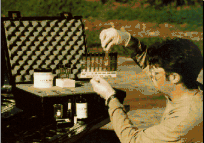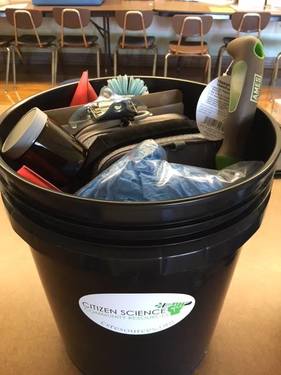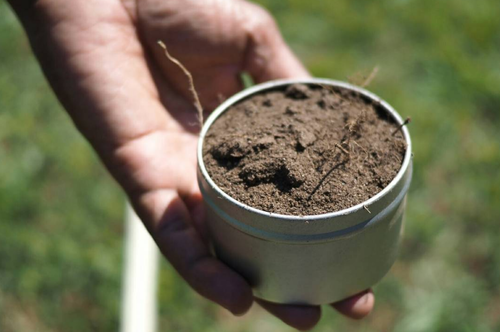
Soil Contamination
A soil contaminant is an element (also known as ‘heavy metals’ or inorganic contaminants, e.g. lead) or a chemical (also known as ‘organics’, e.g. diesel oil) present in the soil at a level that poses health risks to plant, animal or human health. Common soil contaminants include heavy metals, pesticides, polychlorinated biphenyls (PCBs), polycyclic aromatic hydrocarbons (PAHs), and petroleum products.
This page is a place to collect and organize resources on investigating soil pollution. Visit the soil tag page to see the latest community posts about soil on Public Lab, and get updates on this topic by subscribing:
See community stories and projects on soil
Join the conversation
- Ask a question, answer a question, or follow future questions on soil
- Post an issue brief that describes your local concern related to soil
- Find resources to get started with investigating your soil
- Read more about common soil contaminants and why you might test soil for contaminants
- Learn about different soil testing methods
- Do or add an activity
Find further reading and resources on soil
See what’s still unknown and next step challenges in soil testing and monitoring
Community stories and projects
Projects on soil monitoring
Public Lab community projects tagged with soil-projects will appear here
soil-projects, or post links here!
Additional community projects and stories
- Urban Soils Institute: based out of New York, the Urban Soils Institute researches urban soils, offers soil testing services and educational programs, and facilitates collaborative projects blending soil science and art.
- Gardenroots - A Citizen Science Garden Project: out of the University of Arizona and led by Dr. Mónica Ramírez-Andreotta. Gardenroots creates community-engaged research to evaluate environmental quality in rural gardens in several Arizona counties and beyond.
- The JAM (Jornadas de Autodefensa Medioambiental) video series by @imvec: “a series of online conversations about citizen environmental self-defense,” including a call with Nuestros Suelos.
- Safe Urban Harvests Study: investigating heavy metal pollution in farms and urban gardens in Baltimore, Maryland.
- Our Soil / Nuestros Suelos: with @abbykinchy and @sureta, Our Soil and Nuestros Suelos are “community-based participatory research projects centered around soils and heavy metal contamination in Troy, New York, USA, and Atacama Region, Chile, respectively,” including development of a community soil study toolkit.
Join the conversation
Questions from the community
- See if other community members are asking questions like yours
- Ask a question so other community members can offer support
- Sign up below to be notified when someone asks a soil-related question
Questions tagged with question:soil will appear here
Post an Issue Brief
Share a local concern or issue about soil contamination and get support from the Public Lab community by writing and posting an Issue Brief. Visit “Write an Issue Brief” to find information on what an issue brief is, see examples, and learn how to write one.
Research soil contamination
The Public Lab community is here to support people as they plan and carry out investigations into their soil. Anyone can ask questions, start an issue brief with any amount of information available, or start documenting a project, and gather input from other Public Lab members.
Some places to start
Here are some activities for getting started with examining your soil. They involve gathering information that can help you make decisions about what to do next.
Information on soil contamination
And here’s more background information on soil contamination, including how humans can be exposed to soil pollution and descriptions of common soil contaminants.
Where does soil contamination come from?
We can be exposed to contaminants through the soil through:
- Skin contact: dermal exposure. E.g. pesticides
- Inhalation: breathing in dust. E.g. asbestos, lead; and/or contaminants that vaporize from soil, e.g. benzene
- Ingestion: eating of dust and soil through hand-to-mouth and to a lesser extent through eating foods grown in contaminated soil as some can uptake heavy metals
With exposure to any contaminant, the likelihood that health effects will occur depends on how harmful or toxic the contaminant is to humans, how much you are exposed to, and for how long and often you are exposed.
Contaminants in soils can come from historical industrial activity, past and present land use, nearness to pollution sources (i.e. a major road, a coal plant) and natural disasters.
Contaminants can end up in your soil through:
- the air (from dust & exhaust)
- water (from rain & groundwater & runoff from a nearby site)
- direct deposition (from on site (e.g. Pesticide application, burning garbage, or nearby polluters).
Why test the soil for contaminants?
People test their soil for contaminants for a range of reasons:
- To see if the soil is safe to grow food in and/or reduce risk of exposure to contaminants through existing or future farms and gardens.
- To see whether contaminants may have been or are being deposited on your site through runoff (water) or air from nearby busy roads or polluting industries.
- To see what the contaminants may have been left behind on the soil after a natural disaster such as flooding or fire, or a chemical spill.
- To see whether remediation efforts are working.
Also see this great overview by Toxics Action Center
Common soil contaminants to be aware of:
Heavy metals
Heavy metals are those elements which are toxic to humans at certain concentrations, including:
- arsenic
- copper
- lead
- mercury
- nickel
- chromium
- cadmium
- zinc
- aluminum
- manganese
- barium
- molybdenum
Some of them, like zinc and copper, are necessary or beneficial to living organisms in small concentrations but are toxic above a certain concentration; others, like lead, cadmium and mercury, serve no known biological function and are always toxic. Heavy metals are naturally occurring, found in rocks, soil systems and bedrock, and in some places a certain metal may be naturally present in higher concentrations (such as arsenic in New York State).
The majority of heavy metal contamination arises from human activity– metal mining and smelting, agrochemical fertilizers and pesticides, sewage sludge, oil and gas operations and fossil fuel burning, improper waste disposal, and fill used in residential development. Unlike organic contaminants, heavy metals cannot be broken down, so the they keep building up in soils. But their characteristics may change so that they can be more or less easily taken up by plants or animals.
Organic Chemicals
Organic contaminants are carbon-based, meaning they are derived or manufactured from something that was once alive, for example, oil and gasoline, which is the remains of plant and animal matter that was compressed for millions of years, then pumped out of the earth and processed. Polycyclic Aromatic Hydrocarbons (PAHs) and other petroleum hydrocarbon contaminants, solvents like trichloroethylene (TCE), dioxins, chemical pesticides, and Polychlorinated Biphenyls (PCBs) are a few organic contaminants of note. They can be present in soils, particularly on or near historical or present-day oil and gas industry, auto and machine repair shops, old or leaky oil tanks, busy roads or highways, landfills and dumps, beneath electrical stations and wires, and places where there were building fires or demolished buildings.
Polycyclic Aromatic Hydrocarbons (PAHs)
PAH’s are a byproduct of incomplete combustion, and are released when fossil fuels are burnt. They are common in soils along busy roads due to vehicle exhaust, and are associated with coal burning power plants, forest fires, and road sealants. Other sources of PAHs include wood burning stoves and oil spills. There are more than 15 different types of PAH’s. Some PAHs are known to be cancer-causing, or carcinogenic. They have also been associated with respiratory illnesses. In soils, PAHs are likely to stick tightly to soil and organic matter particles; though certain PAHs move through soil to contaminate underground water or volatilize into the air.
Polychlorinated Biphenyls (PCBs)
Though they were banned in 1979, they are still present in the environment because they are highly persistent (do not readily break down) and can leak from landfills where they have been disposed of and from products that were made before the ban. They were used broadly in the electrical and building industries, and so are common in soils beneath electrical transformers and capacitators, flooded areas, and soils where buildings have been demolished. Since they don’t really break down, and bind to fats, they end up in our water and in our fish and seafood. So it’s especially important to know if they are present in places where people fish!
You can read more about each specific contaminant through the Agency for Toxic Substances and Disease Registry’s 2 page fact sheets, called Tox FAQ’s: [https://www.atsdr.cdc.gov/toxfaqs/index.asp ]
Designing your soil study
Planning how you’ll go about investigating your soil involves designing a study. The exact way your study looks and what methods you use will depend on what contaminants you might be looking for, and what you ultimately wish to do with the results.
Public Lab posts on study design:
- Things to Consider When Testing Soil for Contaminants
- Question: If I'm worried about soil pollution, how should I decide where to take samples?
- Start an environmental monitoring study
Additional resources on planning a soil sampling and testing study:
- Statistics for Action Soil Quality Guide: includes an introduction to soil testing and guidance on planning and carrying out soil sampling and testing.
- Cornell Waste Management Institute - Guide to Soil Testing and Interpreting Results: includes guidance on how and where to collect soil samples (how many, how deep).
Soil testing methods
This spreadsheet lists several different soil testing methods and tools, the contaminants they can detect, information on how to use the method, the cost, and more. Please share any knowledge or experience you have with these methods by adding to the spreadsheet!
soil will appear at https://publiclab.org/methods#soil
Methods for screening purposes
These soil testing methods use different approaches to screen for contaminants. In general, the data these methods produce are less accurate and precise than certified lab-based methods, but the methods are more accessible in terms of materials, cost, and logistics. Many screening methods are available as kits or portable units that can be used quickly in the field.
Certified or lab-based analytical methods
Soil testing methods that are certified by government agencies (like the US Environmental Protection Agency) or certification programs (like the North American Proficiency Testing Program) generally provide the most accurate and precise results on the kinds and amounts of contaminants in soil. These methods are often lab-based techniques that test soil samples collected from a site. Costs vary depending on what contaminants you’re testing for, and it can get expensive if you’re testing several samples.
Many university labs and extension offices can also test soil samples for contaminants, but consider lab certification requirements if you intend to use the results in court.
Example posts and wikis on how to sample soil for lab-based testing are below.
Lab analysis
- This “Guide to Testing Soil for Heavy Metals” from John Hopkins Safe Urban Harvests study lists several labs for heavy metal tests and includes the cost per sample.
Understanding and interpreting soil test results
Wiki pages tagged with interpret-soil-tests will appear here
| Title | Updated | Version | Views | Likes | |
|---|---|---|---|---|---|
| Making meaning of soil test results and reports | over 3 years ago by laurel_mire | 5 | 324 | 1 |
Tools for mapping and viewing data
Activities for understanding your soil
Activities on Public Lab that have been tagged with activity:soil will appear here
Activities should include a materials list, costs and a step-by-step guide to construction with photos. Learn what makes a good activity here.
Soil remediation
Soil remediation involves cleaning up or containing polluted soils. There are many different ways to reduce exposure to contaminated soils, and remediation methods vary in how effective they are and how much they actually reduce the problem or simply move the problem from one place to another.
Further reading and resources
- Soil Contaminants in the Garden: factsheet from the Duke Superfund Research Center
- Soil Contamination: factsheet from the Healing City Soils program
- Soil Quality indicator sheets: from the United States Department of Agriculture
- A “Soil 101” video from Queens Public Library: information on lead in soil begins at the 37-minute mark.
- Ashraf M.A., Maah M.J., and Yusoff I. 2014. Soil Contamination, Risk Assessment and Remediation. In Environmental Risk Assessment of Soil Contamination, edited by Hernandez-Soriano M.C. IntechOpen.
Wikis on soil
| Title | Updated | Version | Views | Likes | |
|---|---|---|---|---|---|
| Infragram | over 2 years ago by warren | 123 | 23,326 | 10 | |
| Soil Contamination | almost 3 years ago by laurel_mire | 29 | 4,129 | 6 | |
| Soil remediation | about 3 years ago by laurel_mire | 10 | 714 | 1 | |
| Bioassay | about 3 years ago by alejobonifacio | 7 | 1,041 | 3 | |
| Topics | about 3 years ago by bhamster | 22 | 19,299 | 3 | |
| Making meaning of soil test results and reports | over 3 years ago by laurel_mire | 5 | 324 | 1 | |
| Screening for soil contamination | over 3 years ago by bhamster | 2 | 369 | 0 | |
| MeteoMex: online monitoring of climate and volatile organic compounds | over 4 years ago by liz | 2 | 286 | 1 | |
| Soil Sampling Toolkit | almost 6 years ago by Bronwen | 10 | 915 | 5 | |
| Madeira | about 7 years ago by warren | 14 | 522 | 1 | |
| Soil Sampling | over 7 years ago by warren | 2 | 1,670 | 3 | |
| Open Land | almost 9 years ago by eustatic | 3 | 379 | 1 |
Next step challenges
Several areas for potential development on soil testing and monitoring work include:
- Find and share information on ways to biologically test for soil contaminants that's analogous to macro-invertebrate testing for water. Possibly soil microscopic life? Also known as bioassays. Earthworms are known to be pretty good indicators of toxicity but more info and experimentation is needed so that this could be applied by communities.
- NEW for March 2021: wiki page on bioassays. One particular idea is breaking down and creating more DIY techniques for the bioluminescence inhibition assay: culturing the bacteria, developing solutions for extracting contaminants from soil samples, measuring light output with a photometer, and plotting graphs correlating light output to contaminant level.
- Identifying ways to reduce lab cost for sampling that requires lab testing (for eg., mass spectrometry for validity and reliable data). Partnering with university labs' is one way, or advocating for agriculture extension offices to provide subsidized testing. Do you have other ideas?
- Play with the DIY spectrometer and build up a database to compare with for each toxic metal and organic contaminant at different concentrations. Create a color chart based on the database with many replicates (people trying it out) to compare the colors shown from reaction with each metal and contaminant of concern.
- Figure out which reagents are effective for DIY colorimetric /spectrophotometric tests for soil contamination, and how to produce them.
- Testing and modifying water quality test kits for detecting heavy metals so they can be used for soil. See this comment for context.
- Examine the potential for sensor-based detection of soil contaminants. Can the principles applied in air sensors that detect chemicals be transferred to soil testing?
- Open source applications that automate color change detection in reagent-based tests.









